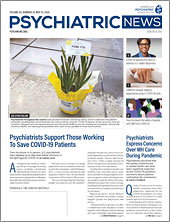The Substance Abuse and Mental Health Services Administration (SAMHSA) has seen an 890% increase in the number of people calling its Disaster Distress Helpline, a subnetwork of the national Suicide Prevention Lifeline.
According to Richard McKeon, Ph.D., M.P.H., chief of the Suicide Prevention Branch at SAMHSA’s Center for Mental Health Services, the jump in crisis calls to the Disaster Distress Helpline began when awareness of the COVID-19 pandemic intensified in the United States (approximately early March). And although many of the network’s 170 local crisis call centers have also reported increases in call volume, McKeon noted that calls to the national Suicide Prevention Lifeline have not changed dramatically.
“The response to COVID is the largest-scale response in the Disaster Distress Helpline’s history,” he said.
Some states, such as Maine, also have implemented warmlines—telephone lines for mental health support and needs that have not yet reached a crisis stage—for frontline emergency and medical staff and other first responders to access support for job-related stress, anxiety, depression, trauma, sleep disturbance, substance misuse, and other psychiatric symptoms. These warmlines were not developed in response to the COVID-19 pandemic. Nonetheless, they represent an important pathway to mental health services for clinicians and other professionals struggling with concerns about the virus and its effects (for example, social isolation, job loss, and family separation).
McKeon said that SAMHSA has plans to analyze in greater detail the content of and patterns among COVID-19 calls (for example, geographic origin, and caller demographics) to the Disaster Distress Helpline with the goal of better understanding which individuals are expressing an increased need for mental health services stemming from the pandemic as well as the nature of their concerns (for example, isolation and job loss).
“Everything that is happening now just underscores the importance of the availability of these services—both the national Suicide Prevention Lifeline and the Disaster Distress Helpline,” explained McKeon. “In a time when face-to-face services are not always possible, having the availability of these services—remotely and around the clock, without charge—is more important than ever.”
Lifeline Boosted by Local Centers
Since 2001, SAMHSA has provided infrastructure funding to the Suicide Prevention Lifeline network crisis call centers in all states and the District of Columbia. The Lifeline answers an average of about 2.2 million calls annually, two-thirds of which are directed to one of the local crisis centers. The remaining are military-related calls routed to the Veterans Administration hotline.
“The national Lifeline effort really rests on the shoulders of the local crisis centers that answer these calls,” said McKeon. “These local community crisis centers need all the support they can get moving forward in their mission. Although SAMHSA tries to provide what support we can to their efforts, some receive very limited, if any, [local] government funding.”
Local crisis centers engage in a variety of tasks. They first work to calm the caller, as described in the Lifeline’s Guidelines for Callers at Imminent Risk; use mobile outreach teams when available; and dispatch police or ambulance assistance only as a last resort. Ensuring caller safety and welfare is also imperative. Although dissemination of mental health information and mental health service referrals are not their core responsibilities, they do perform these duties.
“About 25% to 30% of callers are actively suicidal at the time of the call,” said McKeon. “Other calls might be family members concerned about someone or a person thinking about suicide not on that day but maybe recently. So, there’s a certain diversity to the calls on the Lifeline.”
Call centers are also diverse in their capabilities. For instance, unlike the Veterans Crisis Line, most local crisis centers do not have access to callers’ electronic medical records and thus do not have their medical and psychiatric histories on hand. However, some call centers do have expanded capabilities for individualized service. For instance, Georgia’s Crisis and Access Line is run by Behavioral Health Link service, which allows dispatchers to make real-time appointments for callers in the state’s community mental health system.
Although some local crisis centers have seen a growing influx of calls since the COVID-19 crisis began, McKeon emphasized the significance of psychiatrists’ involvement in these centers year round, whether as volunteers or as sources for follow-up treatment and service provision.
“Every crisis center needs places to refer to. And there may be other kinds of consultation that psychiatrists could provide or relationships that could be established, and that varies from center to center,” he stated. “But if psychiatrists are willing to accept referrals from a crisis center in their area, that would be most welcome.”
Interested psychiatrists should contact their local crisis center to ask how they can best serve the hotline and its callers. Local crisis center contact information is posted
here (scroll down to “Find Your Center”). ■
The Disaster Distress Helpline can be reached by phone at (800) 985-5990 or by text at 66746 and enter “TalkWithUs.”
The National Suicide Prevention Hotline’s phone number is (800) 273-8255.

